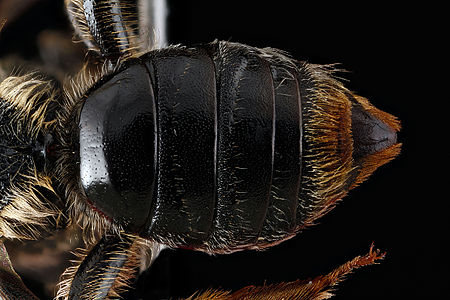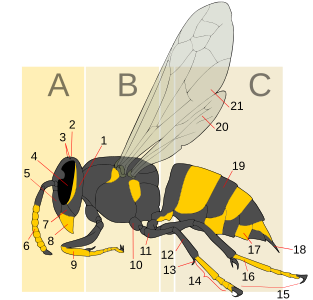Tergito

Un tergito o terguito, escrito también tergum (del latín "la espalda"; pl. terga, adjetivo asociado tergal) es la porción dorsal ("superior") de un segmento de los artrópodo poseterior a la cabeza. El borde anterior se llama "base" y el borde posterior se llama "ápice" o "margen". Un tergo determinado puede dividirse en placas endurecidas o escleritos comúnmente también denominados tergitos.[1]
En un segmento torácico, el tergum puede dividirse en un notum anterior y un escutelo posterior. Las extensiones laterales de un tergito se definen como paranota (del griego, "a lo largo de la espalda") o carinae (del latín, "quilla"), ejemplificadas por los milpiés de espalda plana del orden Polydesmida .
Los kinorrincos marinos también tienen placas tergales y esternales, aunque aparentemente no son homólogas a las de los artrópodos.[2]
El Tergo-tergal es un mecanismo estridulador en el que las finas espinas de los tergitos abdominales se frotan entre sí para producir sonido.[3] Este proceso se conoce como telescopio abdominal.[3]
Ejemplos
[editar]-
Tergum abdominal (dividido en varios terguitos) de unaabeja.
-
Siete escleritos claramente visibles en el lomo de un escorpión preñado.
-
Un terguito de estaavispaestá etiquetado como 19.
-
Tergitos torácicos de variostrilobites.
Referencias
[editar]- ↑ McCafferty, W. Patrick (1983). Aquatic entomology: the fishermen's and ecologists' illustrated guide to insects and their relatives. Jones and Bartlett. p. 20. ISBN 9780867200171. Consultado el 30 de abril de 2020.
- ↑ Sørensen, MV; Dal Zotto, M; Rho, HS; Herranz, M; Sánchez, N; Pardos, F; Yamasaki, H (2015). «Phylogeny of Kinorhyncha based on morphology and two molecular loci». PLOS ONE 10 (7): e0133440. Bibcode:2015PLoSO..1033440S. PMC 4511640. PMID 26200115. doi:10.1371/journal.pone.0133440.
- ↑ a b Field, Laurence H; Roberts, Kelly L (2003). «Novel use of hair sensilla in acoustic stridulation by New Zealand giant wetas (Orthoptera: Anostostomatidae)». Arthropod Structure & Development (en inglés) 31 (4): 287-296. PMID 18088987. doi:10.1016/S1467-8039(03)00005-7.
Text is available under the CC BY-SA 4.0 license; additional terms may apply.
Images, videos and audio are available under their respective licenses.




